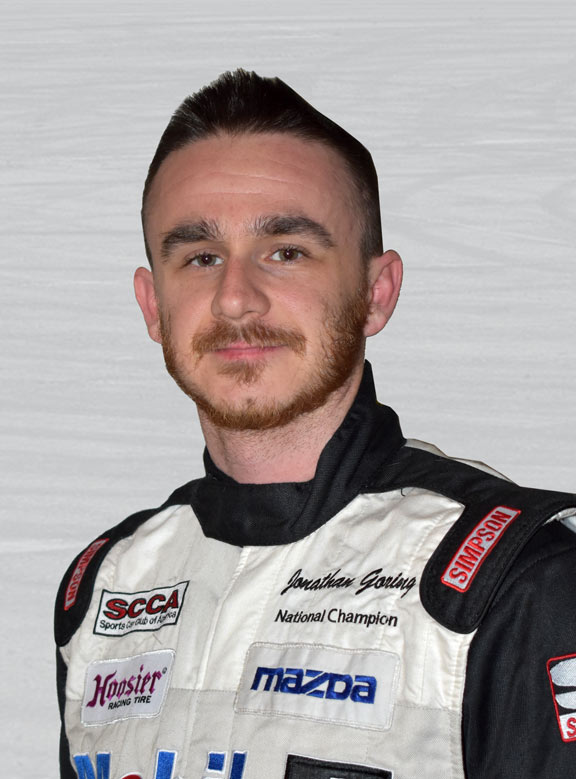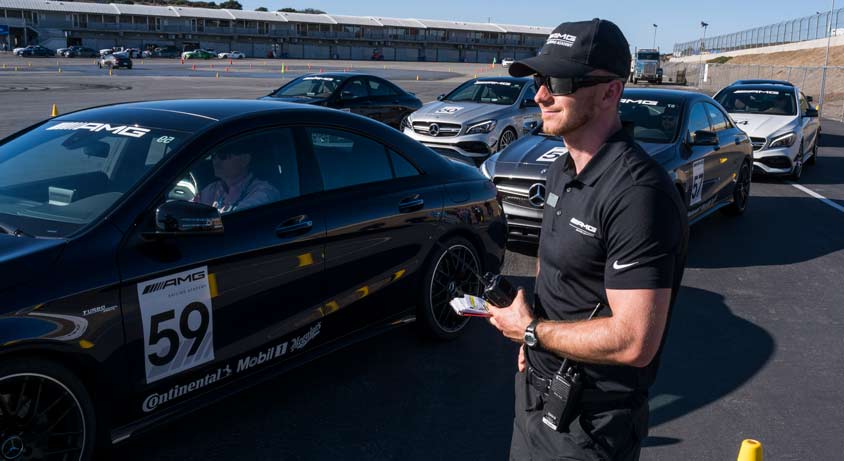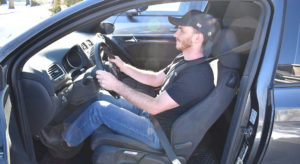“I mean how hard can it be, you just sit there and push the pedals and turn the wheel!” – Most of the american general public
Oh, how mistaken they really are. Contrary to public opinion, racing is tough. Really tough!
I want to ask you a question.
What better luxury could the track driver have than to possess the ability to process all the information that comes in during an on track session in a calm, stress free manner?
Did you know that the more physically fit a racing driver is, the less physical strain they feel, the better focused they are mentally out on the race track?
The moment the performance driver feels any sort of physical fatigue on track, they have already been mentally fatigued for quite some time.
If a driver could be far superior fitness wise than the rest of the field during a race, they’ll be the coolest under pressure and give themselves the best possible chance at minimizing mistakes.
There isn’t a single advantage in racing that is less expensive to have. Especially if you’re over the class minimum weight!
Being fit is a no brainer when it comes to being fast and consistent out on track, but it is one of the areas that is often underutilized.
A Turning Point
When I was 15 years old and in my transition from karts to cars, I experienced the concept of being too slow in the turn simply because I wasn’t strong enough. I discovered that a higher downforce car, a Swift 016 Formula Atlantic car in my case, required actual, brute strength in most higher speed turns.
My corner speed at Turn 1 at Road Atlanta was limited by my physical strength.
I couldn’t turn the wheel hard enough at the speed the car could roll in. Even with a really good seat, it was a struggle to support my weight with my core, trying not to hold myself up with the wheel. I remember the G loading to be so heavy on my eyes it was difficult to stay orientated, my vision being slightly distorted from changing direction so fast.
Wow.
This was a game changer. I really needed to train like an athlete, and thus began my fitness journey.
What I Did
Part of my fitness adventures included a N.A.S.M. (National Academy Of Sports Medicine) Personal Training Certificate with a specialization in Fitness Nutrition. In addition to studying the textbooks, I pushed my body hard and experienced a massive change in body composition despite maintaining a similar weight in the end. This time, more muscle, less body fat, better cardiovascular conditioning and improved flexibility.
I followed a Bodybuilding style workout & nutrition plan, weight training 5-6 days/week and doing cardio as much as 7x/week. Alongside the training routine, I carefully counted calories and essentially ran a series of experiments on my body by adjusting the ratios of proteins to carbs to fats. I did this for close to 5 years, learned an unbelievable amount and established a great athletic base.
Throughout this time period, I was actively driving race cars and was able to monitor the changes in my performance as they came.
What I Believe to be The Optimal Racing Driver
You want a driver with a nice, balanced physique. Moderate muscle size/strength, low-moderate body fat levels and strong cardiovascular conditioning.
The body composition of a race car driver shouldn’t be overly muscular.
You couldn’t fit Ronnie Coleman (8x Pro Bodybuilding Champion) into a Formula 1 car very easily. You could however fit an Olympic sprinter or any athlete with strong, reasonably conditioned muscles.
On the same token, you don’t want someone who’s too skinny or not strong enough.
Like me when I was 15! I was too skinny to optimize the performance of the car and would have benefited from more size and strength.
Body fat wise, the optimal driver would obviously not be overweight or certainly not obese, but I believe it’s ok to be a little “softer” because you run less risk of malnourishment. As long as the athlete is conditioned enough, strong enough and healthy enough on the inside, there is no reason to be excessively lean as you run the risk of minor forms of malnourishment.
The ideal driver would possess very strong neurological reflexes and coordinated motor skills, similar to those of a musician.
A racing driver must operate very precisely a set of controls while being tossed around in the cockpit due to cornering forces, bumps, etc. Imagine playing the guitar on a roller coaster and hitting every note.
Flexible, smooth muscle tissue with no adhesions or knots.
Having knots in your muscles interferes with their ability to expand and contract, which for the racing driver means a less coordinated muscle.
An absurdly developed pair of ankles.
Full range of motion, 360 degrees around, and strong muscularity in all planes of motion around the joint. Having the footwork of a racing god requires a fully functional ankle from a biomechanical standpoint. You have to be really “in tune” with your ankles.
What Type of Exercise Should I Do to Prepare Myself for Race Driving?
The best way to train for racing? More racing! If you’ve never driven a shifter kart before, boy do I have an idea for you….. 🙂
I can’t think of any type of exercise that is “bad” for a racing driver. However, the most feasible ways to gain the most benefits of being a fit racing driver is probably through Strength Training, Cardiovascular Training, Yoga and Foam Rolling.
But before we get into that, let me tell you a bit more about that fit ankle thing….
If you have just 5 minutes a day and want to improve your footwork, do this:
And it’s not that bad, I promise
Download my Ankle Exercise Guide below.
Want to improve your footwork, no matter what, guaranteed?!
Get your ankles fit.
The performance driver needs a full range of motion in each plain of motion in the ankle joint. The musculature surrounding the ankle joint must be strong, well-coordinated and efficient in its movements.
Let me show you my routine. Just download the guide right below!
FREE PDF GUIDE
THE RACE DRIVER’S ANKLE EXERCISE GUIDE
You’ll also receive updates and wisdom once per month. Unsubscribe at any time. We’ll never share your information.
In addition to having super fit ankles, the driver can focus on other important areas of fitness to improve their driving.
Strength Training
Strength Training and lifting weights, in my opinion, is a necessity for anyone looking to perform better mentally on track (everyone) as it’s the most bang for the buck when it comes to overall health, fitness and coordination.
Remember that increasing the strength of your muscles doesn’t just make them move more force, but it also improves the coordination, reflexes and other neurological characteristics of the muscle. Something that is critical for being fast out on track.
Cardiovascular Training
Being in good shape from a cardiovascular perspective is important because your body will quite simply feel more relaxed during the race than stressed during the race.
Everyone knows that their heart rate increases when they work out. This is referred to as your BPM (beats per minute.) With each beat of the heart there is a “stroke volume,” or the amount of blood your heart pumps with each beat. When our heart beats really fast it creates a stressful environment in the body/brain and makes it difficult to focus on tasks that involve decision making, fine motor skills, etc.
When we strengthen our heart, we increase our stroke volume.
Therefore, in order to supply the same amount of blood to the tissues, the body will decrease the amount of beats to compensate. The heart doesn’t have to work as hard and the driver will be presented the opportunity to a better job behind the wheel due to a less stressful environment.
Now let me ask you, do you think it’s easier to race with a steady, calm heart beat or one that is really high?
Case closed for cardiovascular training.
Flexibility, Foam Rolling & The Importance of the Ankle
I mentioned before about the importance of having strong, flexible ankles. Since a racing driver has to be so coordinated on the pedals, we need the most “mind/muscle connection” (how well the brain communicates with the muscles.) we possibly can in all those little muscles around the ankle joint. That, and we want a full range of motion in the joint.
In order to have our bodies adapt to this superhuman athlete ankle standard, we must create exercise stressors that would result in that natural adaptation.
The only way is to train those muscles both hard and often in order to strengthen them.
However, in doing so, we will inevitably create muscle adhesions (muscle knots) and we must follow up the exercise with a foam roller.
Think of foam rolling as self massage. Basically, it’s a hard piece of foam that you roll around on various muscles and try and find tender spots, known as muscle knots. If you don’t own a foam roller, you’d be surprised how many knots you’re carrying around that are probably affecting your everyday life.
Foam rolling helps the muscle recover from the exercise, ensuring nutrient absorption through increase blood flow.
Think of the blood in the muscle tissue like water in a dish sponge. It’s good to ring out the sponge (foam roll) and allow some new water (blood) in to keep the sponge (muscle tissue) clean and healthy. It’s good to let some new blood in the tissue to flush out metabolic waste and carry those essential nutrients to the muscle for absorption.
Conclusion
The most simple, easy to utilize way of going faster is to get your body and your health in check. With racing being such a highly mental sport, the need to stay cool, calm and collected is well understood. And the best way to give yourself this advantage is to improve your fitness.
And if you do nothing else, make sure you keep on top of those ankle exercises 🙂

ABOUT THE AUTHOR
JONATHAN GORING
From 2006 Skip Barber National Champion to 2015 Spec Miata SCCA Runoffs Champion, and with the 2008 IMSA Lites title in between, I’ve been in the racing scene for quite some time. I’ve been fortunate to race against (and beat sometimes) the best drivers in the world currently racing in various top level motorsports.
I’m very passionate about the art/science of performance driving and want to share that passion with you.
WANT TO DRIVE FASTER THAN EVER?
Join my email list for monthly articles, driving tips, exclusive announcements on new things I’m working on and wisdom delivered straight to your inbox! You can unsubscribe at any time.



